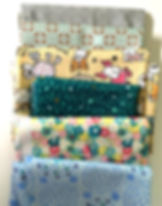Fabric Alphabets
- Sew, Jahit
- Apr 10, 2019
- 3 min read
Updated: Jan 16, 2024
A fun project using scrap fabrics and iron-on polyester batting to make fabric alphabets.

After I was done with the homemade stuffed toys that I made for my son, I was left with remnants of the quilting cottons that frankly, were getting tired and I was eager to use them up. I was inexperienced when I bought those fabrics, so I ended up buying much more than I needed.

I came across the idea of fabric letters. This project was perfect because it would use up the entire remnants, straight-forward to sew, and the end result looked fun.
As usual, I did a lot of Google searches to learn how others have done it, before deciding how I wanted to do it. I eventually settled with using two layers of polyester batting (ironed-on) sandwiched between two layers of the quilting cotton.
I used two layers of batting to give the alphabets a bit more structure and weight.
As for the font patterns, you can download them here. I created this by typing out all the alphabets in Microsoft Words in Arial Black font, and adjusting the text settings by clicking "Font", then "Text Effects". Under "Text Fill", I selected "No Fill". Under "Text Outline", I selected black colour and 0.8 pt width (thicker outlines may result in inaccurate cutting later).

Then, I printed the alphabets and cut them out, ready for tracing onto fabrics.
The next few steps could be done in more than a few different ways, but I figured the following was the quickest and most easily managed:
Step 1: Take one of the paper alphabets and roughly determine the length and width of a rectangle within which the alphabet can be entirely contained with at least half a centimeter clearance from the edges.

Step 2: Cut out two rectangles of fabrics and two rectangles of polyester batting of the dimensions determined in Step 1. The rectangles need not be precise.

Step 3: Iron one batting onto the wrong side of one of the fabrics. Do the same for the other batting and fabric.

Step 4: You now have two "thick" rectangles, each with a layer of fabric and batting fused together. Place these two "thick" rectangles wrong sides together, such that you have a "sandwich" made of of two layers of batting in between two layers of fabric.

And baste the two pieces of "thick" rectangles together, along the outer edges.

Step 5: Trace the alphabet from Step 1 onto either face of the "sandwich".

Step 6: Machine sew along the traced outline of the alphabet.

Step 7: Use a pair of sharp regular scissors to cut about 4 mm outside the sewed lines. You now have a finished fabric alphabet.
Shear scissors are not necessary because the fabrics will not fray since they are already fused to batting. But if you like the zig-zag look, go ahead and use shear scissors.
Now repeat for the other 25 alphabets!

Optional: You may also add binding to all the edges of the alphabets with your choice of binding. This is optional because the fabrics will not fray since they have been fused to the polyester batting. I have added binding to all the edges of my alphabets using this 1" width dark green elastic (you can see it done in the letter "S" in the photo above). However, looking back now, I would definitely have skipped the binding because the elastic tends to distort the alphabets after wash and the whole process of adding binding to all 26 alphabets was just too tedious and unjustified by the result.




